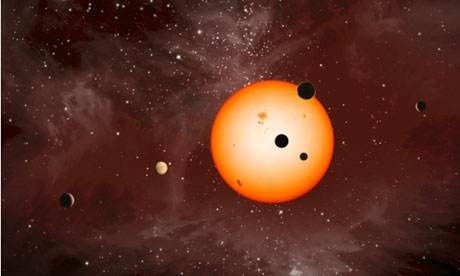 Astronomers have discovered a planetary system made up of six planets orbiting a Sun-like star that is more than 2,000 light years from Earth. It is the largest number of planets found so far around a single star. More than 100 planets have been seen outside our solar system, but most are Jupiter-like gas giants, and almost all are in single-planet systems.
Astronomers have discovered a planetary system made up of six planets orbiting a Sun-like star that is more than 2,000 light years from Earth. It is the largest number of planets found so far around a single star. More than 100 planets have been seen outside our solar system, but most are Jupiter-like gas giants, and almost all are in single-planet systems.
Jack Lissauer, a scientist at Nasa's Ames research centre in California and a lead author on a paper published tomorrow in the journal Nature, said that the Kepler-11 finding was "the biggest thing in exoplanets since the discovery of 51 Pegasi B, the first exoplanet, back in 1995".
The five inner planets of the Kepler-11 system are between 2.3 and 13.5 times the mass of the Earth, and make their orbits in less than 50 days. All of them are so close to their star that their orbits would fit within that of Mercury in our solar system. The sixth planet has an orbital period of 118 days and sits at a distance from its star that is half the Sun-Earth distance.
Lissauer said it was unexpected to find a system where planets could be so close to one another and there could be so many of them on such a flat plane. "The Kepler-11 system is flatter than a CD," he said. "If placed within our solar system, Kepler-11's six planets would lie between those of the sun's innermost planets, Mercury and Venus."
Astronomers found the planets by analysing data from the Kepler space telescope. Every time a planet passes between its star and an observer, it is said to be transiting; by measuring how often and how much the star dimmed in brightness as planets crossed in front of it, they were able to measure the size and density of the planets.
To calculate masses, astronomers measured the slight variations in the orbital periods of the planets caused by gravitational interactions among them.


 Three more Chinese astronauts, or taikonauts, are now marooned in space following the successful return of...
Three more Chinese astronauts, or taikonauts, are now marooned in space following the successful return of... Bret Adee is one of the largest beekeepers in the US, with 2 billion bees across...
Bret Adee is one of the largest beekeepers in the US, with 2 billion bees across...






























